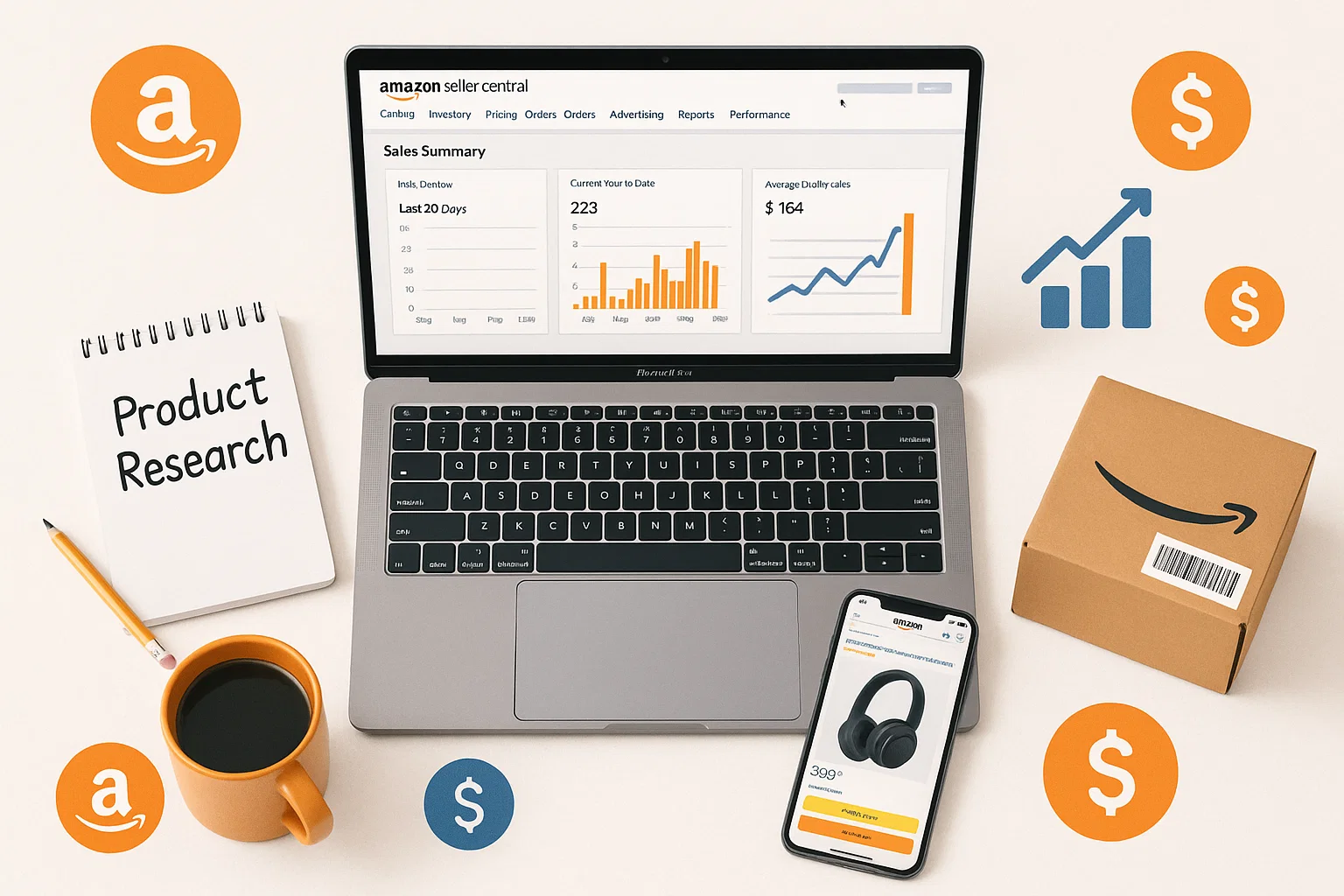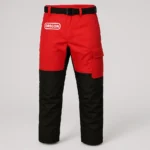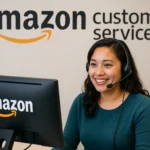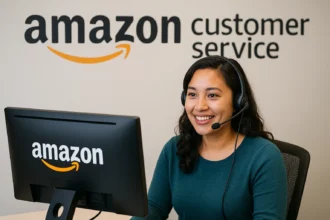introduction to how to sell on amazon
Whether you’re exploring a side hustle or building the next household name in online retail, Amazon gives you the tools and traffic — but it’s up to you to execute. In this article, we’ll cover how to sell on Amazon from scratch, focusing on: how to sell on amazon
What you need to start
Product research & sourcing
How Amazon FBA works
Creating listings that convert
SEO tips to get seen (and clicked)
Scaling your Amazon business
Table of Contents
- Why Sell on Amazon in 2025?
- Step 1: Choose Your Selling Model
- Step 2: Set Up Your Amazon Seller Account
- Step 3: Research Products Like a Pro
- Step 4: Source or Manufacture Your Product
- Step 5: Understand Amazon FBA vs. FBM
- Step 6: Create a High-Converting Amazon Listing
- Step 7: Optimize with Amazon SEO
- Step 8: Launch, Market, and Scale
- Common Pitfalls to Avoid
- Final Thoughts & CTA

Why Sell on Amazon in 2025?
Amazon is no longer “just a bookstore.” It’s a search engine, a logistics platform, and a trusted marketplace where millions shop daily. how to sell on amazon
Key Benefits:
- 400M+ active users globally
- Built-in trust with buyers
- FBA (Fulfilled by Amazon) handles logistics
- Mobile-first shopping experience
- Opportunities for SEO-rich listings
In short, Amazon offers an incredible infrastructure — especially for those who understand how to leverage product listings, SEO, and customer trust. how to sell on amazon
Step 1: Choose Your Selling Model
There are multiple ways to sell on Amazon. Pick the one that suits your resources and risk tolerance. how to sell on amazon
Retail Arbitrage
- Buy discounted products locally, resell on Amazon how to sell on amazon
- Quick to start, but not scalable how to sell on amazon
Wholesale
- Buy in bulk from established brands
- Higher startup cost, but sustainable
Private Label (Recommended for Growth)
- Source a generic product, add your brand and packaging
- Higher profits, full control, long-term brand equity
Dropshipping
- Supplier ships directly to customer
- Low investment, but limited control and higher risk how to sell on amazon
Step 2: Set Up Your Amazon Seller Account
To begin, go to sellercentral.amazon.com and choose from two types of accounts: how to sell on amazon
Individual Seller Account:
- No monthly fee
- £0.75 per item sold
- Best for hobby sellers
Professional Seller Account:
- £25/month flat fee
- No per-item fee
- Required for bulk listings and access to ads, reports, etc. how to sell on amazon
Required Documents:
- Business or individual tax ID
- Bank account
- Government-issued ID
- Credit card
Step 3: Research Products Like a Pro
This is where success starts. Your product must have demand, manageable competition, and healthy profit margins. how to sell on amazon
What Makes a Good Product:
- Lightweight (<3 lbs)
- Compact size
- Durable (no breakables)
- Priced between £15–£50
- Consistent demand (not just trends) how to sell on amazon
Tools for Product Research:
- Jungle Scout
- Helium 10
- AMZScout
- Google Trends + Amazon Best Sellers
Product Validation Tips:
- Avoid patented items
- Read competitor reviews to find gaps
- Look for products with <200 reviews but solid rankings how to sell on amazon
Step 4: Source or Manufacture Your Product
Once you validate an idea, source it.
Where to Source:
- Alibaba.com (for private label)
- AliExpress (for dropshipping)
- Local wholesalers or liquidation sites
- Handmade? You can craft and sell via FBM (Fulfilled by Merchant) how to sell on amazon
Pro Tip:
Always order samples first to check quality. Nothing kills a listing faster than poor product reviews. how to sell on amazon
Step 5: Understand Amazon FBA vs. FBM
Fulfilled by Amazon (FBA):
- Amazon stores, packs, ships
- Handles returns, customer service
- Prime badge = better conversion
- Higher fees how to sell on amazon
Fulfilled by Merchant (FBM):
- You (or your team) pack and ship
- More control, lower fees
- No Prime badge unless eligible for SFP (Seller Fulfilled Prime)
If you want to scale quickly and don’t want to handle logistics, go with FBA.
Step 6: Create a High-Converting Amazon Listing
Even if your product is great, a poor listing will tank sales. Treat your Amazon listing like a landing page. how to sell on amazon
Elements of a Killer Listing:
- Title (up to 200 characters): Include primary keywords
- Images: Use all 7 slots. Show product in use.
- Bullet Points: Focus on benefits, not just features
- Product Description: Tell a story, answer objections
- Backend Search Terms: Fill in with LSI keywords
Step 7: Optimize with Amazon SEO
Selling on Amazon = mastering Amazon’s A9 search algorithm.
Key Ranking Factors:
- Keywords in title, bullets, and backend
- CTR (click-through rate)
- Conversion rate (sales vs. views)
- Review quality and quantity
- Inventory health (don’t go out of stock!)
Amazon SEO Tips:
- Do keyword research using Helium 10 or Magnet
- Front-load the most important keywords in titles
- Use variations and synonyms in backend fields
- Monitor rankings weekly with Seller.Tools or Keyword Tracker
Step 8: Launch, Market, and Scale
Launch Strategy:
- Run PPC ads from Day 1 (Sponsored Products)
- Offer a 10-20% discount to early buyers
- Use social media (Reels, YouTube Shorts, TikTok)
- Collect reviews (using follow-up emails via tools like FeedbackWhiz)
Post-Launch Scaling:
- Add more keywords to your ads
- Launch related products in your niche
- Create a brand store
- Use off-Amazon traffic (Pinterest, Instagram, YouTube)
Don’t Forget:
Set up Amazon Brand Registry as soon as possible — it gives access to A+ content, brand analytics, and more control over listings.
Common Pitfalls to Avoid
Amazon is amazing, but it’s not without risks. Avoid these beginner mistakes:
Picking a “Me Too” Product
Don’t sell what 1,000 others are selling unless you can do it better.
Underestimating Amazon Fees
Calculate everything: storage, referral, FBA, and ad costs.
Ignoring Reviews
Bad reviews can kill conversion. Engage and improve.
Running Out of Stock
Amazon punishes stockouts in rankings. Stay replenished.
Violating Policies
No fake reviews, no keyword stuffing, no shady hacks. Ever.
Final Thoughts & CTA
Selling on Amazon in 2025 is still one of the smartest ways to build a scalable online business. Yes, the competition is tougher. But the opportunity is massive — especially if you treat it like a business, not a lottery ticket.
Let’s recap:
Choose your model wisely (private label = best long-term)
Do deep product research
Write SEO-optimized, high-converting listings
Leverage Amazon’s traffic and infrastructure
Use SEO, PPC, and social proof to grow
Build a brand, not just a listing
Ready to Start Your Amazon Journey?
👉If this guide helped you, there’s much more where that came from.
Visit BuzzCraze.co.uk for more:





